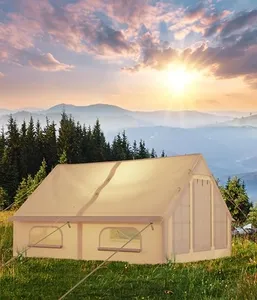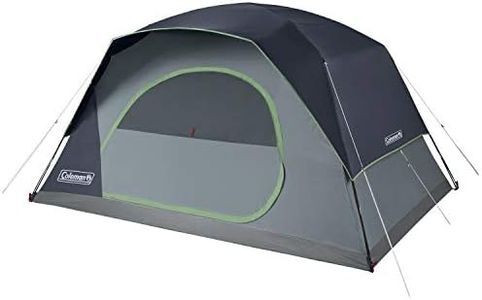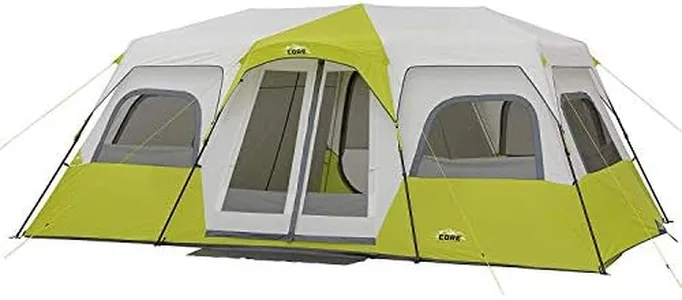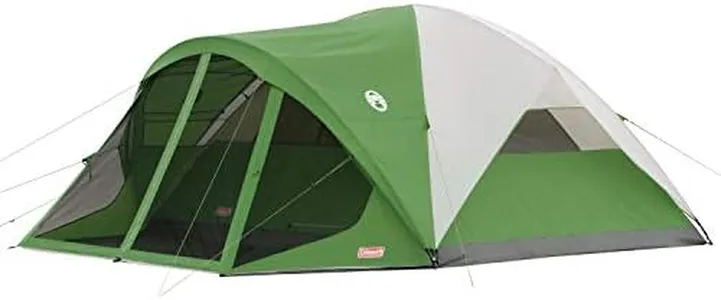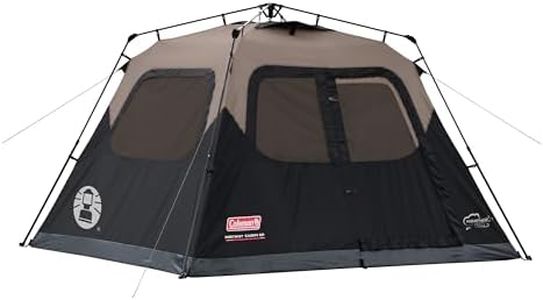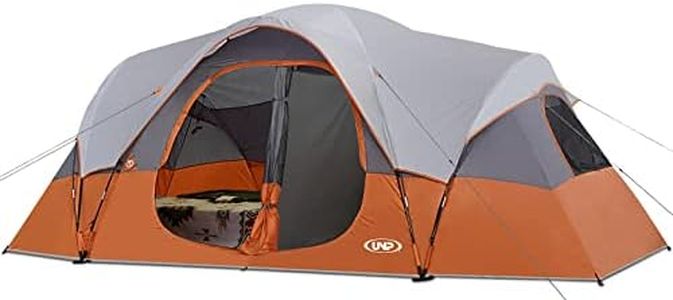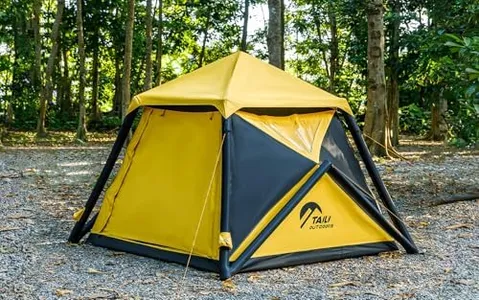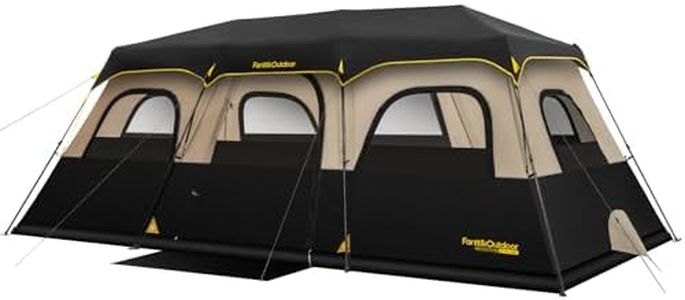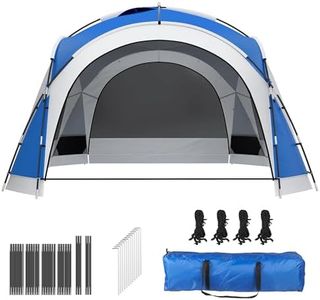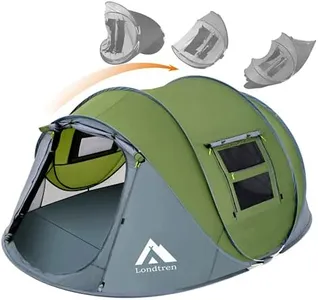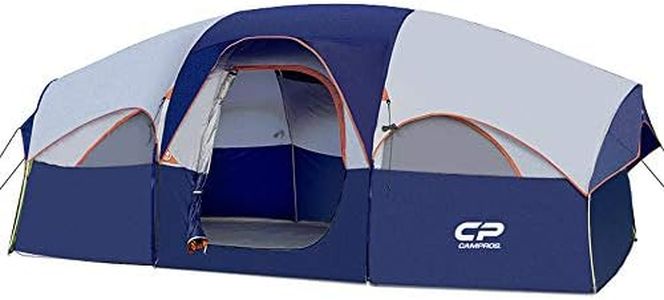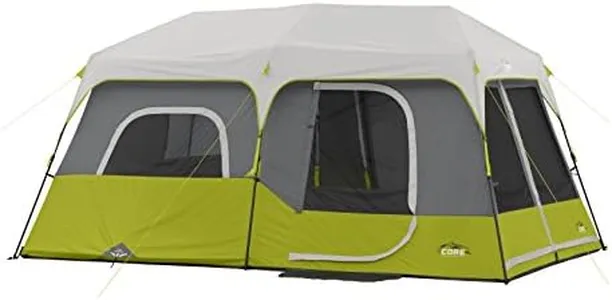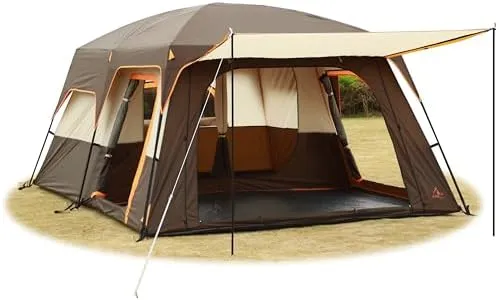10 Best Camping Tents 2025 in the United States
Our technology thoroughly searches through the online shopping world, reviewing hundreds of sites. We then process and analyze this information, updating in real-time to bring you the latest top-rated products. This way, you always get the best and most current options available.

Our Top Picks
Winner
Coleman Skydome Tent with 5 Minute Setup, 8-Person Weatherproof Tent with Rainfly & Carry Bag, 20% More Headroom Than Traditional Canopies
The Coleman Skydome Camping Tent is a versatile option available in multiple sizes to accommodate 2, 4, 6, or 8 people, making it suitable for a range of family or group camping experiences. One of its standout features is the quick setup time, which can be completed in under 5 minutes thanks to the pre-attached poles. This is a major advantage for campers who want to spend more time enjoying the outdoors and less time setting up camp.
The tent offers 20% more headroom compared to traditional Coleman dome tents due to its nearly vertical walls, providing a more spacious interior, which is a definite plus for taller individuals or those who want a bit more room to move around. The WeatherTec system ensures good water resistance with a tub-like floor, welded corners, and inverted seams to keep water out, while the strong frame can withstand winds up to 35 mph, ensuring durability in various weather conditions.
The inclusion of mesh storage pockets and a gear loft helps keep small items organized, and the wider door design facilitates easy movement of larger items like air beds and sleeping bags in and out of the tent. However, at 19.32 pounds, this tent might be on the heavier side for those who prioritize lightweight gear, especially if you need to carry it over long distances. The tent's material is primarily nylon, with fiberglass poles, which should be handled with care to avoid damage. Despite these drawbacks, the Coleman Skydome Camping Tent is a solid choice for families and groups who value quick setup, extra headroom, and reliable weather protection for their camping trips.
Customer Highlights
A summary of real customer reviews to highlight what shoppers are saying!CORE 12 Person Instant Cabin Tent | Large 3 Room Family Pop Up Tent for 2 Minute Camp Setup | Included Storage Pockets for Camping Accessories
The CORE 12 Person Instant Cabin Tent is designed for families or groups needing ample space and quick setup during camping trips. One of its standout features is the Instant Pop-Up Technology, allowing users to set up the tent in about two minutes, which is a significant advantage for those who want to minimize hassle upon arrival. With dimensions of 18 by 10 feet and a height of 80 inches, it can fit three queen-sized air beds or comfortably store gear for up to six people, making it versatile for various group needs.
Weather protection is another strong point, with H20 Block Technology and a waterproof fabric rated at 1200mm. This ensures you stay dry during unexpected rain, and the fully zipped windows add extra protection while providing ventilation. The adjustable ventilation system, which includes lower vents and a mesh ceiling, is excellent for maintaining airflow, especially in warmer weather.
On the downside, the tent weighs around 47.8 pounds, which can be cumbersome for those looking for a lightweight option to hike into remote areas. While it's designed for three-season use, those camping in harsher winter conditions might find it lacking in insulation. Additionally, while it includes room dividers for privacy, the actual number of vestibules is not specified, which might limit gear storage options outside the main sleeping area.
Customer Highlights
A summary of real customer reviews to highlight what shoppers are saying!Coleman Evanston Screened Camping Tent, 6/8 Person Weatherproof Tent with Roomy Interior Includes Rainfly, Carry Bag, Easy Setup and Screened-in Porch
The Coleman Evanston Screened Camping Tent is a versatile option suitable for families and groups, offering a spacious and comfortable environment. It can accommodate 6 to 8 people, making it ideal for larger gatherings. One of its standout features is its weatherproof design, with welded corners and inverted seams to keep water out, and an included rainfly for added protection. The tent measures 15 x 12 feet with a center height of 6 feet, providing ample space and enough room to stand up and move around comfortably.
The screened-in porch adds an extra touch of convenience, allowing for bug-free lounging and additional storage space. It sets up relatively quickly in about 15 minutes, which is great for those who want to spend more time enjoying the outdoors rather than wrestling with a complicated setup. The tent is also relatively lightweight at 11.9 pounds, making it easier to transport in the included carry bag.
However, it is designed for 3-season use, which means it might not perform well in extreme winter conditions. The fiberglass poles, while functional, aren't as durable as some other materials, potentially affecting long-term use. Ventilation is decent due to the screen room, though in hotter climates, it might require additional airflow solutions. In summary, the Coleman Evanston Screened Camping Tent is a solid choice for fair-weather camping and various outdoor events, offering a roomy, comfortable, and relatively easy-to-set-up shelter. It's a particularly good option for families or groups looking for both space and the convenience of a screened-in porch.
Customer Highlights
A summary of real customer reviews to highlight what shoppers are saying!Buying Guide for the Best Camping Tents
Choosing the right camping tent is crucial for a comfortable and enjoyable outdoor experience. The right tent will protect you from the elements, provide enough space for you and your gear, and be easy to set up and take down. When selecting a tent, consider the environment you'll be camping in, the number of people who will be using the tent, and the type of camping you'll be doing. Here are some key specifications to consider when choosing a camping tent.FAQ
Most Popular Categories Right Now
